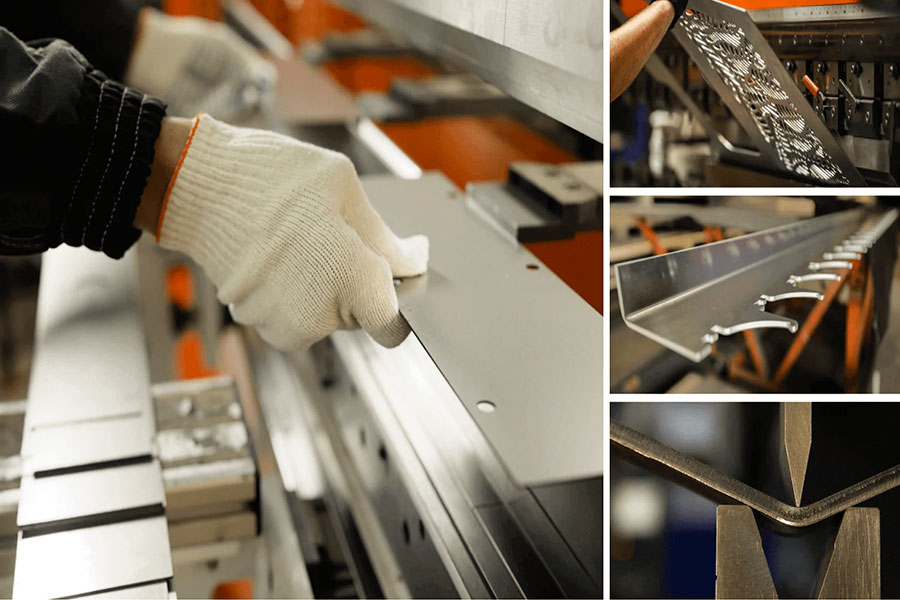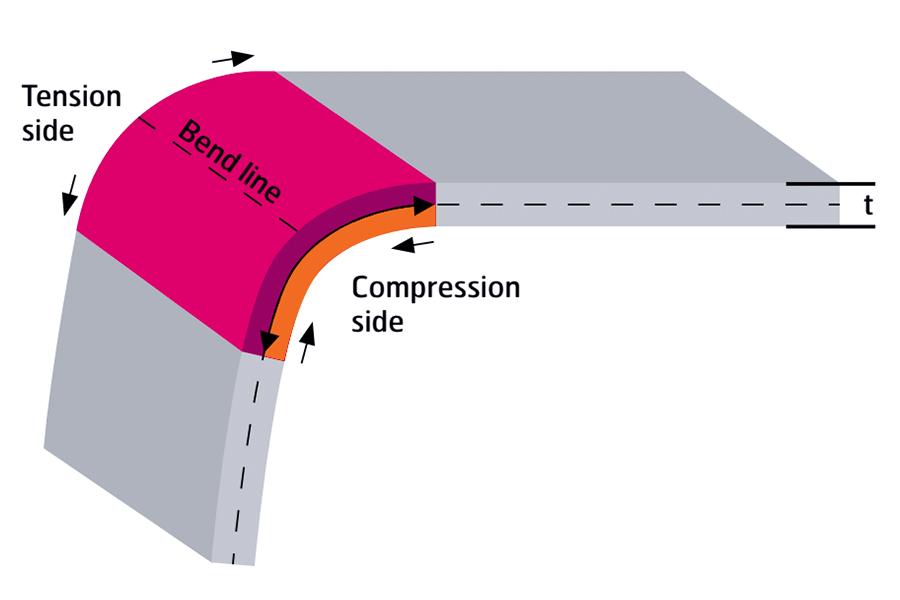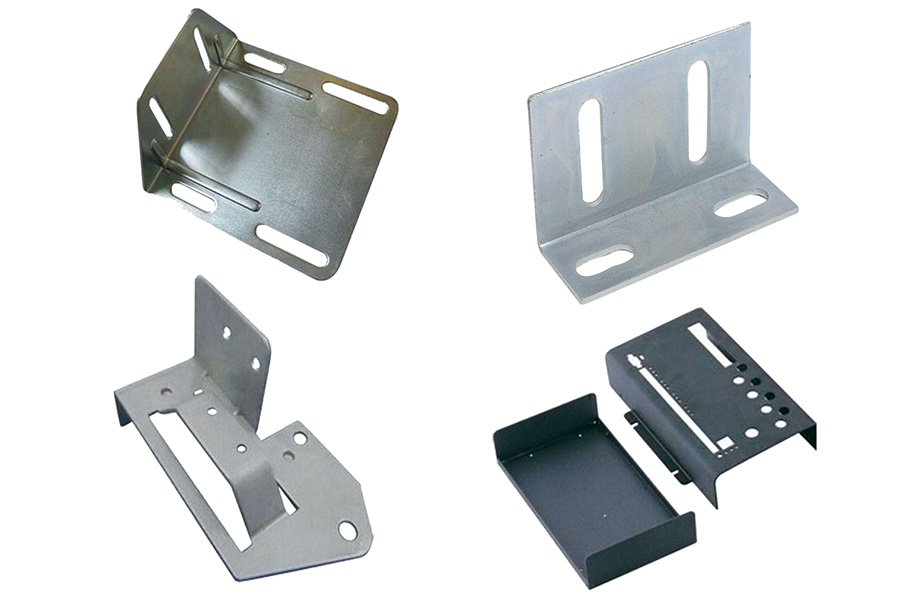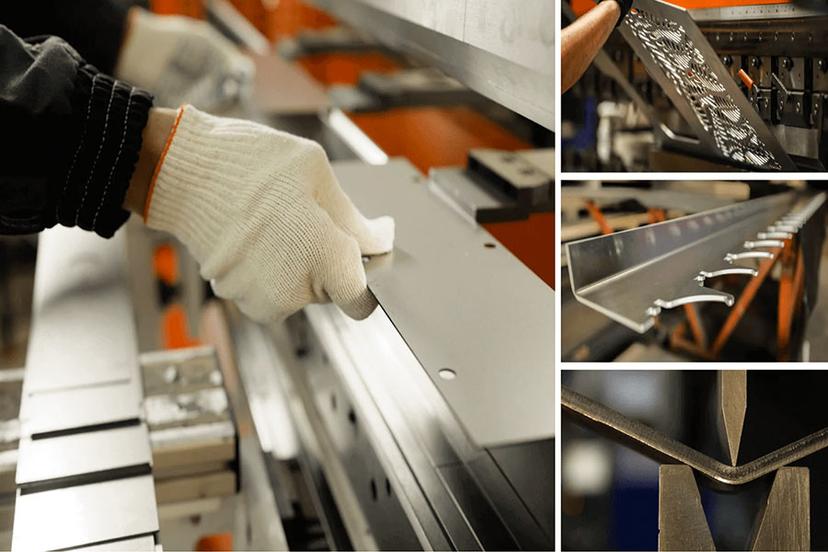Metal bending is a common metal forming process that is widely used in many fields of manufacturing, such as automobile manufacturing, home appliance production, machinery and equipment manufacturing, etc. This process bends the metal material into the desired shape and angle by applying external force to meet the functional and aesthetic requirements of the product. This article will introduce in detail the basic principles, applications, and specific steps of metal bending.
What is metal bending?
Metal bending is the use of force to deform metal into different geometric shapes. Bending a thin sheet of metal one or more times to form the final geometry is called metal bending. The thickness of the metal used may vary. The minimum thickness that can be bent is approximately 127mm, the maximum thickness depends on the material type and thickness. Typically, the thickness of the steel plate does not exceed 6 mm. Generally, the bend radius should be equal to or greater than the material thickness.

How Does metal bending work?
Metal bending is the process of plastically deforming a metal material by applying external force to form a desired shape. Its working principle is based on the mechanical properties and plastic deformation laws of metal materials. When external force acts on a metal material, relative slippage between atomic layers will occur inside the metal, causing the overall material to bend and deform. This process requires controlling parameters such as the size, direction and location of the force application point of the external force to ensure that the required bending shape and forming quality are obtained.

What are the commonly used methods for metal bending?
There are many methods for metal bending, and different methods can be selected according to the characteristics of the material and processing requirements.
Manual bending: For thinner, softer metal materials, hand tools such as pliers, hammers, etc. can be used for bending. This method is simple and direct, but the accuracy and efficiency are relatively low.
Mechanical bending: For thicker or harder metal materials, special mechanical equipment such as bending machines, plate rolling machines, etc. are usually required for bending. These devices are capable of applying greater force and achieving precise bends with preset angles and bending dies.
Thermal bending: Certain metal materials, such as aluminum, copper, etc., have good plasticity and thermal conductivity. In the hot bending process, the metal material is first heated to a certain temperature, and then mechanical force is used to bend it. Heat bending can reduce the elastic modulus of metallic materials, making them easier to bend.
Rolling bending: Rolling bending is a bending method that exerts large forces on metal materials. By placing a metal material between the rollers of a rolling machine, gradually increasing force is applied, causing the metal material to bend with the movement of the rollers.
What are the tools for metal bending?
Metal bending tools mainly include the following categories:
1. Bending machine
The bending machine is one of the most commonly used tools in metal bending. It can be divided into many types according to its type and function:
- Hydraulic bending machine: Powered by a hydraulic system to bend metal sheets. This type of machine has great power and good stability, and is suitable for bending large metal sheets.
- Servo electric bending machine: Using servo motor and control system, it has the characteristics of high precision and high efficiency. Through programming settings, the bending processing of workpieces can be automatically completed, which is suitable for high-precision and high-efficiency production requirements.
- CNC bending machine: Using advanced CNC system, it has a higher degree of automation and processing accuracy. By inputting processing parameters, the CNC bending machine can automatically complete operations such as positioning, clamping, bending and unloading of workpieces, greatly improving production efficiency and processing quality.
2. Special bending mold
Special bending molds are important accessories for bending machines and are used to bend metals of specific shapes and sizes. These molds are usually made of high-strength, high-hardness materials to ensure they are not damaged or deformed during the bending process. Depending on the thickness, material and bending angle of the metal sheet, molds of different shapes and sizes need to be selected.
3. Plate rolling machine
The plate rolling machine is also an important equipment for metal bending. It is mainly used to roll metal sheets into cylindrical, conical or other shapes. The working principle of the plate rolling machine is to apply pressure to the metal plate through rollers, causing it to plastically deform and roll into the required shape. Plate rolling machines have a wide range of applications in the field of metal processing, such as manufacturing pressure vessels, pipes, etc.
4. Pipe bending machine
Pipe bending machines are mainly used for bending metal pipes. It can bend metal pipes into various shapes and angles through different molds and process parameters. Pipe bending machines have the advantages of high processing efficiency and easy operation, and are widely used in pipeline installation and maintenance in petroleum, chemical industry, electric power and other fields.
What are the different types of metal bending?
The range of metal bending processes is wide and varied, with a variety of techniques used depending on the specific application.
1.V-Bending:
This method is very common and is utilized for mostbending needs. The method uses a “punch” and “V-die” to bend the sheet metal to specified angles. In this process the punch applies force on the sheet metal at the location over the V-die. As a result of the force from the punch an angle is formed in the sheet metal. The V-bending method is relatively efficient because it can be utilized for bending steel plates without having to change their position.
There are three commontypes of V-bending:
※Coining
Coining is a bending process in which the punch and the work piece bottom on the die. This produces a controlled angle, which leads to little spring back. There is more tonnage required on this type of bending than in air bending and bottom bending.
The advantages of coining are that, in order to produce outstanding results, accuracy is essential and that is precisely what the coining method can provide. Along with being accurate, repeating the results is also an easy task when it comes to using this technique. Spring back is also less common when using coining, meaning that the metal is less likely to return to its original state.
※Bottom Bending
Bottom bendingalso uses a punch and V-shaped bottom die, just like air bending. What’s different is that the punch is used to push the metal fully into the die to create a bend. Bottom bending (or bottoming as it’s otherwise known) gets its name because the metal is forced to the bottom of the die. Higher pressures are used, and the metal comes into full contact with the punch and the die.
Because the material is pressed into the bottom of the die, the die that is used will determine the bend angle that’s achieved. With bottom bending, you have to change the die to achieve a different bend angle. This isn’t the case with air bending because the punch can just be pushed to a different depth in the die. Bottom bending results in less springback and creates more accurate angles. The big disadvantage is that each new bend radius requires a different bottom die, which means swapping it manually on the machine. The machinery is also put under more pressure during production.
※Air Bending
Partial bending, or air bending, derives its name from the fact that the working piece does not actually touch the tooling parts entirely. In partial bending, the workpiece rests on 2 points and the punch pushes the bend. Is still usually done with a press brake but there is no actual need for a sided die. Air bending gives much flexibility. Let’s say you have a 90° die and punch. With this method, you can get a result anywhere between 90 and 180 degrees. Though less accurate than bottoming or coining, this kind of simplicity is the beauty of the method. In case the load is released and the material’s springback results in a wrong angle, it is simple to adjust by just applying some more pressure. Of course, this is a result of lessened accuracy compared to bottoming. At the same time, partial bending’s big advantage is that no retooling is necessary for different angle bends.
2. Roll Bending
Thismetal bending techniqueinvolves bending the sheets into curved forms. This technique makes use of roll bending sheet metal criteria, that involve the use of three rollers, a hydraulic pressing system along with a brake. The distance between the three rollers allows the manufacturer to bend the sheets in curves.
3. U-bending
U-bending is exactly similar to the V-bending method. This method makes use of a U-shaped punch along with a U-shaped die. The only difference between V- bending and U-bending is that the resulting sheet is in a U shape instead of a V shape.
4. Rotary bending
The rotary bending method is deployed wherever a bending of greater than a 90-degree angle is required. It can also be considered similar to that of V-bending, but the output in this process is more uniform and aesthetic as the metal sheet bending machine used in this method doesn’t scratch the surface of the sheet.
5. Edge bending
This technique of edge bending sheet metal helps the manufacturer to bend the edges without damaging them. The sheet metal edge bending method is most commonly utilized in those sections of sheet metals that are shorter than the remaining metal part. It helps eliminate the sharpness of the corners and increases the aesthetic appearance of the outcome.
6. Wipe bending
This bending method makes use of a wipe die. The sheet of metal is carefully placed inside the wipe die, and a pressure pad applies pressure on the sheet. Later on, the punch is used to make the desired bend in the sheet.

What Materials Are Suitable for Metal Bending?
You cannot bend elastic-plastic materials on a press brake. You may also damage the machine if you try to do this. Special care must be taken when deciding on materials for metal bending during manufacturing. Let’s take a look at some of the best materials recommended for metal forming and bending.
- Carbon Steel:Carbon steel is one of the most flexible and strongest materials used in sheet metal manufacturing. Since the material is recyclable, it also helps reduce the carbon footprint.
- Aluminum:Aluminum is mainly used in lightweight applications. Special care must be taken when bending aluminum to prevent the material from slumping or cracking at the corners.
- Stainless steel:When the final product needs to be strong and durable and the metal strength is high, stainless steel is the first thing that comes to mind. Stainless steel also requires the use of high-power sheet metal bending machines to form products.
- Titanium:Titanium is a corrosion-resistant and strong material, ideal for metal bending technology. If your product is medical or sports equipment, titanium should be your material of choice.
- Copper:Cost is the most corrosion-resistant material, but also the lowest cost. Copper enables high-precision sheet metal bending. Copper is a proven material used extensively by many metal bending industries for a variety of purposes.
These are the best materials for all types of sheet metal bending. Carbon steel is the most commonly used of the above materials. There are many other metals that can be used in the bending process. But be sure to do adequate research before settling on the material.

FAQs
How does bending metal work?
Bending metal is the process of plastically deforming a metal material into a desired shape by applying external force. Its working principle is based on the mechanical properties and plastic deformation laws of metal materials. When external force acts on a metal material, relative slippage between atomic layers will occur inside the metal, causing the overall material to bend and deform. This process requires controlling parameters such as the size, direction and location of the force application point of the external force to ensure that the required bending shape and forming quality are obtained.
How is metal bending achieved?
There are many ways to achieve metal bending. Common methods include: Manual bending: For thinner and softer metal materials, hand tools such as pliers and hammers can be used for bending. This method is simple and direct, but the accuracy and efficiency are relatively low. Mechanical bending: For thicker or harder metal materials, special mechanical equipment such as bending machines, plate rolling machines, etc. are usually required for bending. These devices are capable of applying greater force and achieving precise bends with preset angles and bending dies. Thermal bending: Certain metal materials, such as aluminum, copper, etc., have good plasticity and thermal conductivity. In the hot bending process, the metal material is first heated to a certain temperature, and then mechanical force is used to bend it. Heat bending can reduce the elastic modulus of metallic materials, making them easier to bend.
How does a bending machine work?
The bending machine is a machine that can bend thin plates. Its working principle is as follows: when in use, the wire energizes the coil to generate electromagnetic force, thereby clamping the thin plate between the pressure plate and the base. By adjusting the relative position between the pressure plate and the base, the thin plate can be bent at different angles. Modern bending machines are usually equipped with advanced control systems and sensors, which can monitor and adjust various parameters during the bending process in real time, such as bending angle, speed, etc. This enables the bending machine to achieve high-precision, high-efficiency automated production.
Summary
Metal bending is an important metal forming process that plays an important role in the manufacturing industry. High-quality metal bending can be achieved by rationally selecting processing methods, accurately controlling influencing factors, and following specific steps. With the advancement of science and technology and the development of manufacturing industry, metal bending processing technology is also constantly innovating and developing, injecting new impetus into the development of manufacturing industry.
Disclaimer
The content on this page is for reference only.LSdoes not make any express or implied representation or warranty as to the accuracy, completeness or validity of the information. No performance parameters, geometric tolerances, specific design features, material quality and type or workmanship should be inferred as to what a third party supplier or manufacturer will deliver through the Longsheng Network. It is the responsibility of the buyerseeking a quote for partsto determine the specific requirements for those parts.Pleasecontact usfor moreinformation.
LS Team
This article was written by multiple LS contributors. LS is a leading resource in the manufacturing sector, withCNC machining,sheet metal fabrication,3D printing,injection molding,metal stamping, and more.






